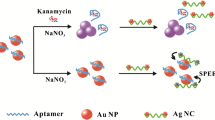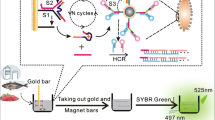Abstract
The authors describe a colorimetric method for determination of kanamycin by using gold nanoparticles (AuNPs) as the element of signal-conversion and by applying hybridization chain reaction-assisted signal amplification. The assay is carried out by monitoring the absorbance change and color change adding salt to the reaction solution containing kanamycin (analyte), hairpin DNA probe, and AuNPs. Three hairpin DNA probes with sticky ends were absorbed on the AuNPs via their sticky ends. Cating with DNA prevents them from salt-induced aggregation (which leads to a color change from red to blue) in the complete absence of kanamycin. In contrast, in the presence of kanamycin, the aptamer hairpin DNA probe binds kanamycin, and the newly exposed section of DNA triggers a cascade of hybridization chain reactions with formation of numerous dsDNAs. On addition of salt, the AuNPs form blue aggregates due to the repulsion between dsDNA and AuNPs. Under optimal conditions, the ration of absorbance at 520 and 630 nm drops with the kanamycin concentration in the range from 1 to 40 μM, and the limit of detection is 0.68 μM. The assay can selectively distinguish kanamycin from other antibiotics. The method was applied to kanamycin detection in (spiked) milk samples and gave excellent recoveries.

Schematic presentation of colorimetric method for kanamycin detection using gold nanoparticles modified with hairpin DNA probes and hybridization chain reaction-assisted amplification.




Similar content being viewed by others
References
Qin L, Zeng G, Lai C, Huang D, Zhang C, Xu P, Hu T, Liu X, Cheng M, Liu Y (2017) A visual application of gold nanoparticles: simple, reliable and sensitive detection of kanamycin based on hydrogen-bonding recognition. Sensors Actuators B Chem 243:946–954
Ma L, Sun N, Tu C, Zhang Q, Diao A (2017) Design of an aptamer–based fluorescence displacement biosensor for selective and sensitive detection of kanamycin in aqueous samples. RSC Adv 7(61):38512–38518
Liu J, Zeng J, Tian Y, Zhou N (2018) An aptamer and functionalized nanoparticle-based strip biosensor for on-site detection of kanamycin in food samples. Analyst 143(1):182–189
Zhu Y, Chandra P, Song K-M, Ban C, Shim Y-B (2012) Label-free detection of kanamycin based on the aptamer-functionalized conducting polymer/gold nanocomposite. Biosens Bioelectron 36(1):29–34
Blanchaert B, Jorge EP, Jankovics P, Adams E, Van Schepdael A (2013) Assay of kanamycin a by HPLC with direct UV detection. Chromatographia 76(21–22):1505–1512
Zhang Y, He HM, Zhang J, Liu FJ, Li C, Wang BW, Qiao RZ (2015) HPLC-ELSD determination of kanamycin B in the presence of kanamycin a in fermentation broth. Biomed Chromatogr 29(3):396–401
Pikkemaat MG (2009) Microbial screening methods for detection of antibiotic residues in slaughter animals. Anal Bioanal Chem 395(4):893–905
Long Y, Hernandez M, Kaale E, Van Schepdael A, Roets E, Borrull F, Calull M, Hoogmartens J (2003) Determination of kanamycin in serum by solid-phase extraction, pre-capillary derivatization and capillary electrophoresis. J Chromatogr B 784(2):255–264
Wei Q, Zhao Y, Du B, Wu D, Li H, Yang M (2012) Ultrasensitive detection of kanamycin in animal derived foods by label-free electrochemical immunosensor. Food Chem 134(3):1601–1606
Qin X, Yin Y, Yu H, Guo W, Pei M (2016) A novel signal amplification strategy of an electrochemical aptasensor for kanamycin, based on thionine functionalized graphene and hierarchical nanoporous PtCu. Biosens Bioelectron 77:752–758
Long F, Zhang Z, Yang Z, Zeng J, Jiang Y (2015) Imprinted electrochemical sensor based on magnetic multi-walled carbon nanotube for sensitive determination of kanamycin. J Electroanal Chem 755:7–14
Li H, D-e S, Liu Y, Liu Z (2014) An ultrasensitive homogeneous aptasensor for kanamycin based on upconversion fluorescence resonance energy transfer. Biosens Bioelectron 55:149–156
Li C, Zhang Y, Eremin SA, Yakup O, Yao G, Zhang X (2017) Detection of kanamycin and gentamicin residues in animal-derived food using IgY antibody based ic-ELISA and FPIA. Food Chem 227:48–54
Chen Y, Wang Z, Wang Z, Tang S, Zhu Y, Xiao X (2008) Rapid enzyme-linked immunosorbent assay and colloidal gold immunoassay for kanamycin and tobramycin in swine tissues. J Agric Food Chem 56(9):2944–2952
Xu Y, Han T, Li X, Sun L, Zhang Y, Zhang Y (2015) Colorimetric detection of kanamycin based on analyte-protected silver nanoparticles and aptamer-selective sensing mechanism. Anal Chim Acta 891:298–303
Zeng S, Yong K-T, Roy I, Dinh X-Q, Yu X, Luan F (2011) A review on functionalized gold nanoparticles for biosensing applications. Plasmonics 6(3):491–506
Liu C-W, Hsieh Y-T, Huang C-C, Lin Z-H, Chang H-T (2008) Detection of mercury (II) based on hg 2+–DNA complexes inducing the aggregation of gold nanoparticles. Chem Commun (19):2242–2244
Sabela M, Balme S, Bechelany M, Janot JM, Bisetty K (2017) A review of gold and silver nanoparticle-based colorimetric sensing assays. Adv Eng Mater 19(12):1700270
Priyadarshini E, Pradhan N (2017) Gold nanoparticles as efficient sensors in colorimetric detection of toxic metal ions: a review. Sensors Actuators B Chem 238:888–902
Dirks RM, Pierce NA (2004) Triggered amplification by hybridization chain reaction. Proc Natl Acad Sci U S A 101(43):15275–15278
Wang X, Jiang A, Hou T, Li H, Li F (2015) Enzyme-free and label-free fluorescence aptasensing strategy for highly sensitive detection of protein based on target-triggered hybridization chain reaction amplification. Biosens Bioelectron 70:324–329
Gao Z, Qiu Z, Lu M, Shu J, Tang D (2017) Hybridization chain reaction-based colorimetric aptasensor of adenosine 5′-triphosphate on unmodified gold nanoparticles and two label-free hairpin probes. Biosens Bioelectron 89:1006–1012
Liu J, Lu Y (2006) Preparation of aptamer-linked gold nanoparticle purple aggregates for colorimetric sensing of analytes. Nat Protoc 1(1):246–252
Luo Y, Xu J, Li Y, Gao H, Guo J, Shen F, Sun C (2015) A novel colorimetric aptasensor using cysteamine-stabilized gold nanoparticles as probe for rapid and specific detection of tetracycline in raw milk. Food Control 54:7–15
Zhou N, Zhang J, Tian Y (2014) Aptamer-based spectrophotometric detection of kanamycin in milk. Anal Methods 6(5):1569–1574
Wang C, Wang C, Wang Q, Chen D (2017) Resonance light scattering method for detecting kanamycin in milk with enhanced sensitivity. Anal Bioanal Chem 409(11):2839–2846
Li H, Rothberg L (2004) Colorimetric detection of DNA sequences based on electrostatic interactions with unmodified gold nanoparticles. Proc Natl Acad Sci U S A 101(39):14036–14039
Acknowledgements
This research was supported by the National Natural Science Foundation of China (No. 31301468).
Author information
Authors and Affiliations
Corresponding author
Ethics declarations
The author(s) declare that they have no competing interests.
Additional information
Publisher’s note
Springer Nature remains neutral with regard to jurisdictional claims in published maps and institutional affiliations.
Electronic supplementary material
ESM 1
(DOCX 1438 kb)
Rights and permissions
About this article
Cite this article
Xu, C., Ying, Y. & Ping, J. Colorimetric aggregation assay for kanamycin using gold nanoparticles modified with hairpin DNA probes and hybridization chain reaction-assisted amplification. Microchim Acta 186, 448 (2019). https://doi.org/10.1007/s00604-019-3574-7
Received:
Accepted:
Published:
DOI: https://doi.org/10.1007/s00604-019-3574-7




